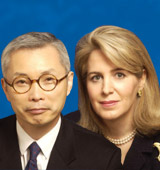|
Executive Interviews: Interview with W Chan Kim & Renee Mauborgne on Blue Ocean Strategy
December 2008
-
By Dr. Nagendra V Chowdary
BOS suggests that it depends on
value innovation not competitive
advantage and must try to attract
non-customers (markets not currently served). Can you elaborate
on what is the distinction between
value innovation and striving for a
competitive advantage and their
connection to BOS?
The natural strategic orientation of
competitive advantage is toward
retaining the existing customers and
seeking further segmentation
opportunities. This often leads to
finer segmentation and greater
tailoring of offerings to better meet
customer preferences. The more
intense the competition is, the greater
the resulting customization of
offerings.
|
|
Although this might be a
good way to gain a focused
competitive advantage and increased
share of the existing market space, it
is not likely to produce a blue ocean
that expands the market and creates
new demand. To create and capture blue oceans,
companies need to take a reverse
course. Instead of concentrating on
customers, they need to look to
noncustomers. And instead of
focusing on customer differences,
they need to build on powerful
commonalities in what buyers value.
This allows companies to reach
beyond the existing demand to
unlock a new mass of customers that
did not exist before. Although the universe of
noncustomers typically offers
substantial blue ocean opportunities,
few companies have keen insight into
who noncustomers are and how to
unlock them. To convert this huge
latent demand into real demand in
the form of thriving new customers,
companies need to deepen their
understanding of the universe of
noncustomers. The book outlines the
three tiers of noncustomers so that
companies can understand how to
identify the universe of their
noncustomers. Once identified,
companies should look across to the
commonalities across noncustomers.
If you focus on these, and not on the differences between them, you will
glean insight into how to desegment
buyers and unleash enormous latent
untapped demand. Your work on BOS does not
highlight as many illustrations from
emerging markets as developed
markets. Was it a well considered
exclusion or out of BOS research's
purview? Do you also notice
emerging markets companies doing
a good job in creating Blue Oceans?
No, not at all. We have numerous
examples from both developed and
emerging markets. When we talk
about blue oceans, most people skip
past value and think of new
territories, new technologies, new
products, new ventures, market
pioneering or first-mover advantage.
But blue ocean strategy is really about
challenging assumptions about
strategy, redefining market
boundaries and making the
competition irrelevant rather than
competing on established ground
regardless of whether you are a first
mover in a developed or developing
marketplace. In our work we have
found that it is possible to create and
capture blue oceans in just about any
setting independent of geography,
competitive environment, economic
outlook, or industry. And this is why
blue ocean strategy is being executed
around the globe in some of the
worlds largest and smallest
companies across industries as
diverse as cosmetics to financial
services. Do you believe that effective BOSs
emerge from desperate situations
rather than from comfort zones?
After all, sticking to status quo
seems to engage the companies than
seeing whats written on the wall?
Our research has revealed that
creation of blue oceans is not
restricted to either successful
companies who are comfortable or
companies with their backs against
the wall. Companies, such as Nintendo (with the Wii) and
Chrysler (with the minivan in the
1980s), have seemingly come back
from the dead to create new markets
and dramatically reshape industry
dynamics. On the other hand,
comfortable incumbents such as 3Ms
Post it Notes or IBM with the
System/360, IBM 650, and countless
other strategic moves were top
suppliers of their industry when they
created blue oceans. We have found
that the creation of blue oceans is a
product of strategy and as such is
very much a product of managerial
action, and not the health, size or age
of the firm. The point is, a blue ocean
will be created if a companys strategic
move achieves value innovation, the
simultaneous pursuit of
differentiation and low cost, by
aligning its utility, price, cost, and
people propositions. If these criteria
are met, a blue ocean will be created
regardless if it is in peril or on top of
the industry
1.
Business Strategy Case Studies
2. ICMR
Case Collection
3.
Case Study Volumes
|
